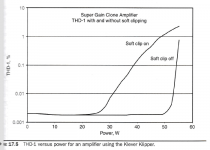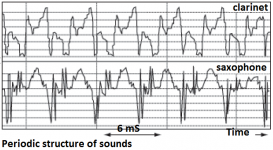I did find the original pic from that KK, attached. You see that the THD starts to rise at half power.
This can be delayed by clipping at a higher level as shown in # 10659 (wow what a thread!), and accounting for higher signal level in the amp of course.
What I would like to check with listening tests is whether there is a preferred combination of early or late onset of soft clipping, and the 'agressiveness' of the clipping (there are conflicting requirements here). Maybe I can get my local audio club to attack this ;-)
Jan
This can be delayed by clipping at a higher level as shown in # 10659 (wow what a thread!), and accounting for higher signal level in the amp of course.
What I would like to check with listening tests is whether there is a preferred combination of early or late onset of soft clipping, and the 'agressiveness' of the clipping (there are conflicting requirements here). Maybe I can get my local audio club to attack this ;-)
Jan
Attachments
Side note:
Crystals used in oscilliators produce frequencies up to a few hundred MHz, by mechanical vibration / deformation.
So the bandwith ratio 44,1kHz sampling frequency digital audio : 200MHz crystal is about 1 : 10.000
If you drive a low frequency crystal hard enough you can hear the sound emitted by the crystal.
Crystals used in oscilliators produce frequencies up to a few hundred MHz, by mechanical vibration / deformation.
So the bandwith ratio 44,1kHz sampling frequency digital audio : 200MHz crystal is about 1 : 10.000
If you drive a low frequency crystal hard enough you can hear the sound emitted by the crystal.
Hi Jan,
I feel that the KK is really unnecessary - as long as the system user is intelligent. I'll take a few clipped peaks over increased distortion at lower levels. Yup, I do lisen that loud on occasion (many occasions!). If you look at the concept of the KK, of course distortion rises early. That is the trade-off.
Hi Bernhard,
Yes, I have heard many crystals. Especially the huge 1 KHz crystals. Driving a 19 KHz (guess what those are in?) hard enough will generte all kinds of noise unrelated to the frequency. But this can really damage the crystal.
-Chris
I feel that the KK is really unnecessary - as long as the system user is intelligent. I'll take a few clipped peaks over increased distortion at lower levels. Yup, I do lisen that loud on occasion (many occasions!). If you look at the concept of the KK, of course distortion rises early. That is the trade-off.
Hi Bernhard,
Yes, I have heard many crystals. Especially the huge 1 KHz crystals. Driving a 19 KHz (guess what those are in?) hard enough will generte all kinds of noise unrelated to the frequency. But this can really damage the crystal.
-Chris
Chris
19 kHz has something to do with fm stereo ? My only guess.
Where have the 1 kHz crystals been used ?
The crystal starts to emit noise before it breaks. Red flag.
19 kHz has something to do with fm stereo ? My only guess.
Where have the 1 kHz crystals been used ?
The crystal starts to emit noise before it breaks. Red flag.
Hi Bernhard,
Yes, the 19 KHz xtal is for FM multiplex oscillators to be multiplied up. The 1 KHz xtals are in old tube audio oscillator equipment, and some industrial (old) equipment. Those are huge and very sensitive to vibrations.
Yes, but they can shift parameters before that. You have to be careful with crystal drive power. By the time the crystal starts to complain you are already overdriving it.
Yes, the 19 KHz xtal is for FM multiplex oscillators to be multiplied up. The 1 KHz xtals are in old tube audio oscillator equipment, and some industrial (old) equipment. Those are huge and very sensitive to vibrations.
Yes, but they can shift parameters before that. You have to be careful with crystal drive power. By the time the crystal starts to complain you are already overdriving it.
Thanks, have never seen one in equipment.The 1 KHz xtals are in old tube audio oscillator equipment, and some industrial (old) equipment.
I think that soft clipping is only for PA amplifiers that are in danger of clipping. High-fidelity amplifiers should not clip in normal use.I did find the original pic from that KK, attached. You see that the THD starts to rise at half power.
Ed
I think you're right. I started to look at the KK or similar solutions to prevent clipping in my high voltage amp, which was destructive.
In the mean time, I made some changes to that amp and now it clips cleanly, so this comes, as we say in The Netherlands, as mustard after the dinner. 🙁
But I was too curious to let it go, as I had a PCB made for it at the time. And Chris asked to go back to Bob's book, and who am I to disregard Chris' wishes 😎
Jan
In the mean time, I made some changes to that amp and now it clips cleanly, so this comes, as we say in The Netherlands, as mustard after the dinner. 🙁
But I was too curious to let it go, as I had a PCB made for it at the time. And Chris asked to go back to Bob's book, and who am I to disregard Chris' wishes 😎
Jan
lol!
Jan, I'm just a guy who deeply respects your work, and continued efforts.
Actually, Rick (rsavas) asked to go back to the book. Good suggestion so he gets the credit!
Jan, I'm just a guy who deeply respects your work, and continued efforts.
Actually, Rick (rsavas) asked to go back to the book. Good suggestion so he gets the credit!
I'm listening (pun intended). Which objective tests (instrument based) beyond freq.response & THD would reveal the lost information?
Are musical instrument signals similar to sine wave signals?
In accordance with such a science as psychoacoustics, it is very important to correctly reproduce the first 18 harmonics of a musical instrument. Moreover, each harmonic must be strictly in its place in time and strictly in its amplitude (no more, no less). Only in this case the sound will have a natural timbre, will be as accurate as possible.
An experiment is known when the recorded signal of a musical note on a magnetic tape was played in the opposite direction. And although all the harmonics of the signal were preserved, none of the experts recognized the instrument.
In 1973, to the definition of timbre given in the ANSI standard, the following was done adding: "timbre depends on the spectrum of the signal, but it also depends on the waveform, sound pressure, the location of frequencies in the spectrum and the temporal characteristics of the sound."
Therefore, for those who do not know this, everything I say is a pun.
Attachments
You're talking utter nonesnse now. Please stop and return to your own thread. You are polluting a valid discussion with garbage now.... it is very important to correctly reproduce the first 18 harmonics of a musical instrument.
I am familiar with that experiement. If you are going to reference something, reference everything or you make it into a lie. There are totally other reasons why the instrument is not recognised and you know it. No, I will not get dragged into stupid discussions that merely waste time.
He has tread-jacked multiple times. That's againts the rules and sin-bin-able.
Jan
Jan

Okay, I try not to be heavy-handed as anyone who knows me is well aware. But I will now give an official warning to you petr_2009.
Any more posts not in the spirit of this thread or that push your unique viewpoint will result in a bin. You are threadjacking as has been pointed out and I was already considering this.

Hi Jakob2,
As presented, petr_2009 is not correct. However you are and that is not in dispute.
As presented, petr_2009 is not correct. However you are and that is not in dispute.
First of all you were wrong because the "Chris" you mentioned is a member, not an Administrator nor a Moderator.
You wanted to talk to @anatech who is an Administrator.
However may be it was better for you as your way of addressing a member of this Forum breaks the Rules of both the Forum and the good education.
I would have gladly ignored your ugly post, but it is really so very rude and there is nothing that can justify it.
There is a lot to justify it. You probably don't know the whole many years history of this pig-headed rude thread-jacking guy that f*cks up and pisses on every thread he wades into. Many members have had patience with him beyond reason to no avail. This was long overdue.
Jan
Jan
I don't know the story at all, but expressing in that way is not a good see nor a nice example for the reader and shames the whole Forum.
Unfortunately, I'm unable to appreciiate and judge a technical disquisition, but generally speaking I think that those who say something different from all the others could are wrong, but could also be right and not be yet understood.
Can we all Audio lovers afford that?
Almost all the new discoveries have seen this.
Just to know a little more of the story, has anyone ever tried to listen to his statement with cooperation and without technical prejudices?
Maybe you all are very right, and maybe it is very probable, but this does not justify to be so rude on an honourable Forum.
My view is the following just as a possibility:
What if by any chance he was right, tomorrow?
Unfortunately, I'm unable to appreciiate and judge a technical disquisition, but generally speaking I think that those who say something different from all the others could are wrong, but could also be right and not be yet understood.
Can we all Audio lovers afford that?
Almost all the new discoveries have seen this.
Just to know a little more of the story, has anyone ever tried to listen to his statement with cooperation and without technical prejudices?
Maybe you all are very right, and maybe it is very probable, but this does not justify to be so rude on an honourable Forum.
My view is the following just as a possibility:
What if by any chance he was right, tomorrow?
- Home
- Amplifiers
- Solid State
- Bob Cordell's Power amplifier book

